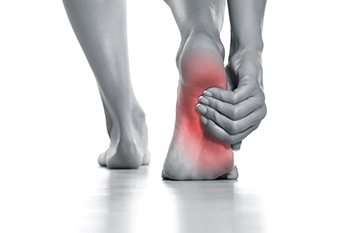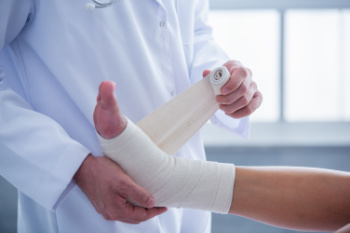
Connellsville


Wearing the wrong shoes can cause heel pain due to poor arch support, insufficient cushioning, or an improper fit. High heels or shoes with a rigid sole can strain the plantar fascia, the ligament connecting the heel to the toes, leading to discomfort. Shoes that are too tight or too loose can also cause friction and pressure points, resulting in heel pain. To prevent this, choose shoes with proper arch support and ample cushioning to absorb impact. Ensuring a correct fit is vital, as shoes should have enough room for your toes and provide a secure fit at the heel. Opt for shoes with a slightly raised heel and a flexible sole to support natural foot movement. These measures can alleviate heel pain and promote overall foot health. If you have heel pain that could be a result of wearing shoes that do not fit right, it is suggested that you consult a podiatrist who can offer you treatment solutions, and guide you toward wearing the right shoes.
Many people suffer from bouts of heel pain. For more information, contact Dr. Arnold Tarpley, Jr. of Tarpley Foot and Ankle Center. Dr. Tarpley can provide the care you need to keep you pain-free and on your feet.
Causes of Heel Pain
Heel pain is often associated with plantar fasciitis. The plantar fascia is a band of tissues that extends along the bottom of the foot. A rip or tear in this ligament can cause inflammation of the tissue.
Achilles tendonitis is another cause of heel pain. Inflammation of the Achilles tendon will cause pain from fractures and muscle tearing. Lack of flexibility is also another symptom.
Heel spurs are another cause of pain. When the tissues of the plantar fascia undergo a great deal of stress, it can lead to ligament separation from the heel bone, causing heel spurs.
Why Might Heel Pain Occur?
Treatments
Heel pain should be treated as soon as possible for immediate results. Keeping your feet in a stress-free environment will help. If you suffer from Achilles tendonitis or plantar fasciitis, applying ice will reduce the swelling. Stretching before an exercise like running will help the muscles. Using all these tips will help make heel pain a condition of the past.
If you have any questions please contact one of our offices located in Uniontown, and Connellsville, PA . We offer the newest diagnostic and treatment technologies for all your foot and ankle needs.

Athlete's foot, a type of tinea infection caused by a fungus, thrives in warm, moist environments, making your feet an ideal breeding ground. However, it's not just athletes who are at risk. Anyone can develop this irritating skin condition. The symptoms of Athlete's foot vary depending on the affected area of the foot involved, ranging from a red, flaky rash to itchy blisters and discolored nails. Some cases of athlete’s foot may require prescription medication, especially if the infection persists or spreads. If you're experiencing recurring symptoms, have multiple affected areas, or notice pus or discharge, it's of extreme importance to seek medical attention from a podiatrist. This foot doctor can accurately diagnose the problem and recommend an appropriate treatment plan tailored to your needs. Maintaining good personal hygiene and keeping your feet dry are essential steps in preventing athlete's foot. If you need help managing tinea infections, it is suggested that you make an appointment with a podiatrist as soon as possible.
Athlete’s Foot
Athlete’s foot is often an uncomfortable condition to experience. Thankfully, podiatrists specialize in treating athlete’s foot and offer the best treatment options. If you have any questions about athlete’s foot, consult with Dr. Arnold Tarpley, Jr. from Tarpley Foot and Ankle Center. Dr. Tarpley will assess your condition and provide you with quality treatment.
What Is Athlete’s Foot?
Tinea pedis, more commonly known as athlete’s foot, is a non-serious and common fungal infection of the foot. Athlete’s foot is contagious and can be contracted by touching someone who has it or infected surfaces. The most common places contaminated by it are public showers, locker rooms, and swimming pools. Once contracted, it grows on feet that are left inside moist, dark, and warm shoes and socks.
Prevention
The most effective ways to prevent athlete’s foot include:
Symptoms
Athlete’s foot initially occurs as a rash between the toes. However, if left undiagnosed, it can spread to the sides and bottom of the feet, toenails, and if touched by hand, the hands themselves. Symptoms include:
Diagnosis and Treatment
Diagnosis is quick and easy. Skin samples will be taken and either viewed under a microscope or sent to a lab for testing. Sometimes, a podiatrist can diagnose it based on simply looking at it. Once confirmed, treatment options include oral and topical antifungal medications.
If you have any questions, please feel free to contact one of our offices located in Uniontown, and Connellsville, PA . We offer the newest diagnostic and treatment technologies for all your foot care needs.

Foot fractures encompass a spectrum of injuries, each demanding specific attention and care. Among them, the Jones fracture affects the fifth metatarsal bone, typically requiring immobilization through casting or surgery to ensure proper healing. Metatarsal shaft fractures, occurring along the long bones of the foot, often necessitate rest, elevation, and the use of crutches to alleviate pressure. Proximal fifth metatarsal tuberosity avulsion fractures involve the pulling away of a small bone fragment due to sudden muscle contractions, often managed with immobilization and gradual return to weight-bearing activities. Additionally, big toe fractures, whether simple or complex, may require splinting, taping, or buddy taping to adjacent toes to promote stability. Relief techniques for foot fractures commonly involve rest and elevation to mitigate swelling and pain. Immobilization aids like casts, braces, or boots help stabilize the injured area, facilitating proper healing. If you have broken your foot, it is strongly suggested that you consult a podiatrist who can determine what type of fracture you have, and offer appropriate treatment methods.
A broken foot requires immediate medical attention and treatment. If you need your feet checked, contact Dr. Arnold Tarpley, Jr. from Tarpley Foot and Ankle Center. Dr. Tarpley can provide the care you need to keep you pain-free and on your feet.
Broken Foot Causes, Symptoms, and Treatment
A broken foot is caused by one of the bones in the foot typically breaking when bended, crushed, or stretched beyond its natural capabilities. Usually the location of the fracture indicates how the break occurred, whether it was through an object, fall, or any other type of injury.
Common Symptoms of Broken Feet:
Those that suspect they have a broken foot shoot seek urgent medical attention where a medical professional could diagnose the severity.
Treatment for broken bones varies depending on the cause, severity and location. Some will require the use of splints, casts or crutches while others could even involve surgery to repair the broken bones. Personal care includes the use of ice and keeping the foot stabilized and elevated.
If you have any questions please feel free to contact one of our offices located in Uniontown, and Connellsville, PA . We offer the newest diagnostic and treatment technologies for all your foot and ankle needs.

Sesamoiditis, a condition caused by inflammation of the sesamoid bones located beneath the big toe joint, can pose significant discomfort and mobility challenges. These small, pea-sized bones play a vital role in weight-bearing and stabilizing the foot during activities like walking and running. When subjected to excessive pressure or repetitive stress, the sesamoid bones may become inflamed, leading to symptoms such as sharp or dull pain beneath the big toe joint, and swelling. Sesamoiditis typically manifests as a gradual onset of pain, worsening with activity and improving with rest. Activities that involve pushing off the toes, such as jumping or running, may worsen symptoms. Diagnosis of sesamoiditis involves a comprehensive evaluation by a podiatrist, including a physical examination and possibly imaging tests such as X-rays or MRI scans. If you have pain under the big toe, it is suggested that you contact a podiatrist who can provide you with effective treatment solutions.
Sesamoiditis is an unpleasant foot condition characterized by pain in the balls of the feet. If you think you’re struggling with sesamoiditis, contact Dr. Arnold Tarpley, Jr. of Tarpley Foot and Ankle Center. Dr. Tarpley will treat your condition thoroughly and effectively.
Sesamoiditis
Sesamoiditis is a condition of the foot that affects the ball of the foot. It is more common in younger people than it is in older people. It can also occur with people who have begun a new exercise program, since their bodies are adjusting to the new physical regimen. Pain may also be caused by the inflammation of tendons surrounding the bones. It is important to seek treatment in its early stages because if you ignore the pain, this condition can lead to more serious problems such as severe irritation and bone fractures.
Causes of Sesamoiditis
Treatment for sesamoiditis is non-invasive and simple. Doctors may recommend a strict rest period where the patient forgoes most physical activity. This will help give the patient time to heal their feet through limited activity. For serious cases, it is best to speak with your doctor to determine a treatment option that will help your specific needs.
If you have any questions please feel free to contact one of our offices located in Uniontown, and Connellsville, PA . We offer the newest diagnostic and treatment technologies for all your foot and ankle needs.